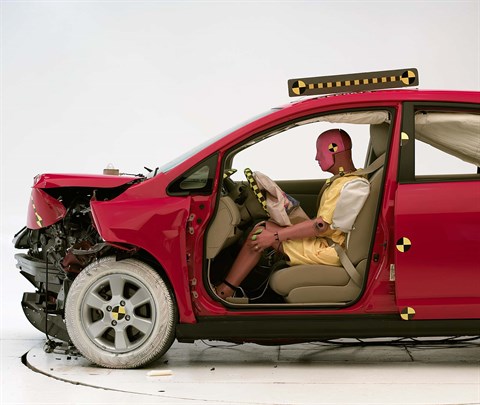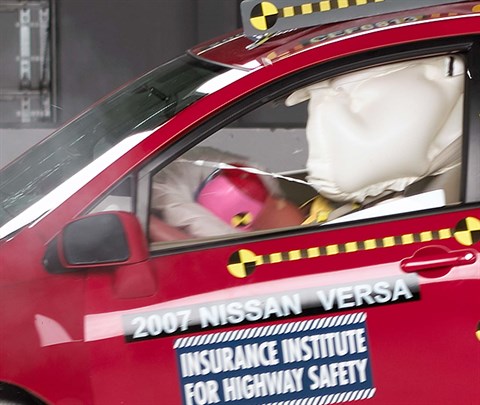Moderate overlap front: original test
Rating applies to 2007-12 models
Tested vehicle: 2007 Nissan Versa 1.8 SL 4-door hatchback
The Nissan Versa was introduced in the 2007 model year. The frontal offset crash test ratings apply to both the hatchback and sedan versions of the car through the 2011 model year. Beginning with 2012 models, the sedan was redesigned but the hatchback was not. Therefore the frontal offset ratings detailed below do not apply to the 2012 model sedan.
| Evaluation criteria | Rating |
|---|---|
| Overall evaluation | |
| Structure and safety cage | |
| Driver injury measures | |
| Head/neck | |
| Chest | |
| Leg/foot, left | |
| Leg/foot, right | |
| Driver restraints and dummy kinematics | |

Action shot taken during the frontal offset crash test.

The dummy's position in relation to the steering wheel and instrument panel after the crash test indicates that the driver's survival space was maintained well.

A high head acceleration occurred when the dummy's head hit the steering wheel through the airbag.

Intrusion into the driver's space was minimal, and all leg and foot injury measures were low.
Side: original test
Rating applies to 2007-10 models built after November 2006
Tested vehicle: 2007 Nissan Versa 1.8 SL 4-door hatchback with standard front and rear head curtain airbags and standard front seat-mounted torso airbags
The Nissan Versa was introduced in the 2007 model year, first as a hatchback and then as a sedan. Beginning with 2007 hatchback models manufactured after November 2006, changes were made to the side torso and side curtain airbags to improve occupant protection in side impact crashes (note: information about when a specific vehicle was manufactured is on the certification label typically affixed to the car on or near the driver door).
The tested hatchback was manufactured after the modifications had been made. All 2007-10 Versa sedans have the modified side airbags.
| Evaluation criteria | Rating |
|---|---|
| Overall evaluation | |
| Structure and safety cage | |
| Driver injury measures | |
| Head/neck | |
| Torso | |
| Pelvis/leg | |
| Driver head protection | |
| Rear passenger injury measures | |
| Head/neck | |
| Torso | |
| Pelvis/leg | |
| Rear passenger head protection | |

View of the vehicle and barrier just after the crash test.

View of the vehicle after the crash with doors removed, showing the side airbags and damage to the occupant compartment.

Smeared greasepaint shows where the driver dummy's head was protected from being hit by hard structures by the side curtain airbag.

Smeared greasepaint shows where the rear passenger dummy’s head was protected by the side airbag.
Roof strength
Rating applies to 2007-11 models
Tested vehicle: 2011 Nissan Versa 1.6 4-door
| Overall evaluation | |
|---|---|
| Curb weight | 2,552 lbs |
| Peak force | 9,414 lbs |
| Strength-to-weight ratio | 3.69 |
Head restraints & seats
Seat type: Manual cloth seats AHR
| Overall evaluation | |
|---|---|
| Dynamic rating | |
| Seat/head restraint geometry |
About the head restraint & seat test
Currently, IIHS tests apply only to front seats.